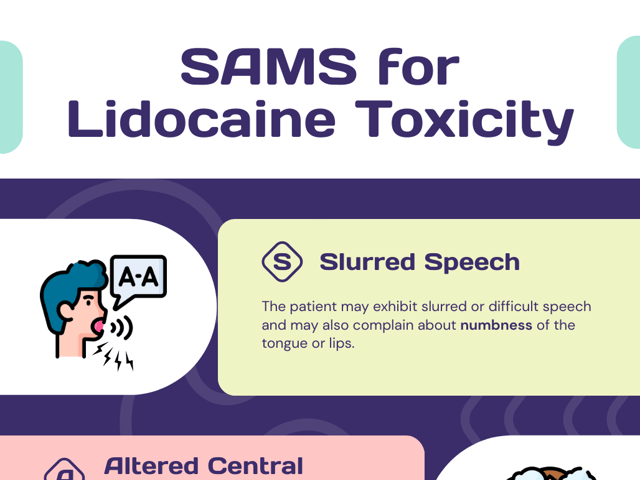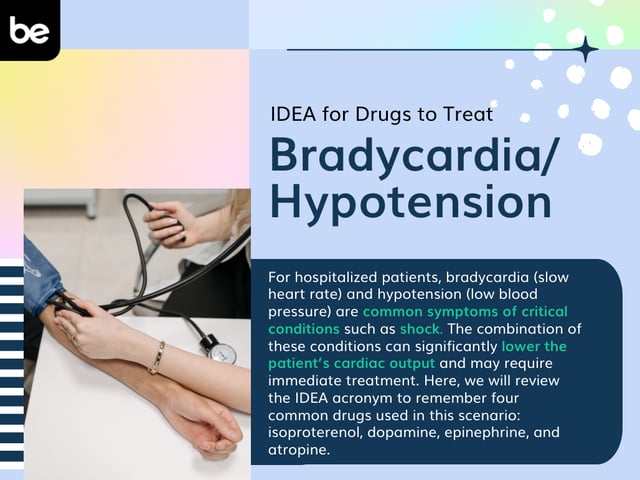
SAMS for Lidocaine Toxicity
Lidocaine is a commonly used local anesthetic drug and can be used for a variety of procedures. It is most often used to numb the skin before surgeries or dental procedures. It can also be used to treat acute pain such as burns or neuralgia or to treat treat arrhythmias, as the drug has antiarrhythmic properties. When applied topically, it reduces itching and pain associated with skin irritations. Finally, it is sometimes used in combination with other medications to treat chronic pain.
Using Lidocaine
Lidocaine can be given intravenously, by injection (such as when performing a nerve block), by inhalation, or topically. In patients with ventricular arrhythmias, it can also be used acutely as an antiarrhythmic treatment. One important note with lidocaine is that because it can be administered in multiple forms and routes, the total amount delivered must be closely monitored to avoid lidocaine toxicity.
Safe and Unsafe Doses for Lidocaine
Lidocaine toxicity can occur when too much of the drug is given. To prevent this, the recommended dose of lidocaine should not exceed 4 mg/kg when given intravenously or 8 mg/kg when given topically. When administered intravenously, the maximum dose of lidocaine should not exceed 300 mg.
For topical applications, the maximum dose should not exceed 500mg. It is important to note that the recommended amounts can vary depending on the individual patient, the route of administration, and the purpose of the drug. Therefore, it is essential to consult a healthcare provider to determine the appropriate dose for the specific situation.
Prevention of Lidocaine Toxicity
The most effective way to prevent lidocaine toxicity is to monitor the amount of lidocaine given and to follow the recommended dosing guidelines. When performing nerve blocks, it is vital to slowly inject the lidocaine to ensure that the nerves are not damaged and to prevent an excessive amount of the drug from entering the bloodstream. Nurses and other healthcare providers should also be aware of contraindications and allergies when administering lidocaine.
It is also important to note that the onset of lidocaine toxicity can be much faster when given intravenously, so healthcare providers must be aware of this and keep a close watch on the patient for signs and symptoms of lidocaine toxicity.
Finally, healthcare providers should be aware of lidocaine’s potential drug interactions and adjust the dosage accordingly. Certain drugs, such as beta-blockers and calcium channel blockers, can increase the risk of lidocaine toxicity. It is important to be aware of this risk and take appropriate precautions when administering lidocaine in combination with other drugs.
Lidocaine Toxicity Signs and Symptoms
Understanding the risks of lidocaine toxicity and knowing the SAMS acronym for the signs and symptoms is essential. Healthcare providers can use this acronym as a quick reminder to look for these warning signs and take appropriate action. It is also important to remember to monitor the total dose of lidocaine to ensure it is within the recommended amount.
Most of these symptoms are more likely to occur when the drug has been given intravenously or intramuscularly.
S—Slurred Speech: The patient may exhibit slurred or difficult speech and may also complain about numbness of the tongue or lips.
A—Altered Central Nervous System: The patient may appear drowsy or restless or also complain of dizziness or confusion. The patient may also have arrhythmias on their EKG. In severe cases, the client may become unconscious.
M—Muscle Twitching: The patient may have tremors and/or muscle twitches.
S—Seizures: In more severe cases, the patient may have seizures or **convulsions. The toxicity can also lead to respiratory depression or arrest.

Treatment for Lidocaine Toxicity
Depending on the administration route and lidocaine toxicity symptoms, the treatment can vary. The options range from administering drugs such as benzodiazepines or lipid emulsions to hyperventilation with high doses of oxygen. In severe cases, cardiopulmonary resuscitation may be necessary.
Other management strategies include providing supportive care and monitoring the patient’s vital signs and laboratory values. Additionally, close monitoring of the patient’s electrocardiogram (ECG) and blood pressure is essential to detect any cardiac rhythm changes. Intravenous fluids, electrolyte replacement, and correcting acid-base abnormalities may also be necessary.
Test your Knowledge of Lidocaine Toxicity and More
In conclusion, lidocaine is a commonly used local anesthetic and can be used to treat a variety of conditions. With proper education and following the recommended dosing guidelines, lidocaine can be administered safely and effectively. It is important to remember that the total dose of lidocaine must be closely monitored to avoid lidocaine toxicity. Nurses and other healthcare providers should keep in mind the potential drug interactions of lidocaine and adjust dosages accordingly. Healthcare providers should also remember the SAMS acronym to look for signs and symptoms of lidocaine toxicity and take appropriate action if toxicity is detected.
To test your knowledge of lidocaine toxicity, or to learn more about other nursing concepts, check out our NCLEX-RN practice tests, study guides, and flashcards.
Keep Reading

National Council Licensure Examination-Registered Nurse Blog
What to Expect in Nursing School Clinicals
The clinical experience is a rite of passage for all nursing students, …

National Council Licensure Examination-Registered Nurse Blog
What is the NCLEX Next Generation (NGN) Exam?
If you’re interested in becoming a registered nurse, you likely know th…

National Council Licensure Examination-Registered Nurse Blog
IDEA for Drugs to Treat Bradycardia/Hypotension
For hospitalized patients, bradycardia (slow heart rate) and hypotensio…